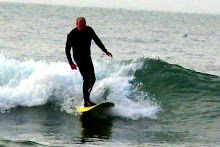
| Bolinas | Groin |
| 9:30 am to 11:00 am | 3' to 4', sets to 6' |
| High upcoming tide | Slight offshore breeze |
| High overcast | Fun session |
Dateline Storm #1 – from Stormsurf.com
“With 36 hrs of 60 – 70 kt winds acting on the ocean’s surface generating estimated seas of 40 ft or greater and expected 84 hrs of seas greater that 30 ft, virtue fetch continues to look likely for the US West coast providing a higher than usual set wave count in the 17 – 20 sec period energy bands, peak energy to top out in the 23 sec period range.
North CA: Expect swell arrival starting near sunrise Saturday (10/25) with period 22 – 23 secs. Size creeping up as period drops, peaking just after sunset 9.0 – 9.5 ft @ 18 – 19 secs (16 – 18 ft faces) … Swell to continue into Sunday at 8 – 9 ft @ 16 secs early (13 – 14 ft faces) fading to 14 secs by sunset.”
As noted above, the first winter north swell arrived this weekend. I heard spectacular reports regarding epic waves at Bolinas. My son spoke of long lines of six-foot waves from the Channel to the Groin on Sunday. Mark the archaeologist surfed Saturday and Sunday and was still feeling it in his arms Monday morning. It was crowded and judging by the license plate frames on the cars, several surfers from San Francisco were out at Bolinas. This is not unusual. Whenever big swells generate monstrous unrideable waves at Ocean Beach, the San Francisco surfers come to Bolinas, one of the few places with rideable surf. With thirty shortboarders out at the Groin, Mark went to the Patch and had a great time. Doug reported that Sunday he surfed the Patch. Doug hates the Patch but due to the shortboarder crowd, he too went out at the Patch.
“Loren, I never had caught so many waves at the Patch, head-high, long, long rides,” Doug said to me out in the water Monday morning.
Remnants of the swell were still running this morning: 6.2 foot swell at 15 seconds producing three to four foot waves with sets to six feet at the Groin, powerful, thick waves with fair shape. A big peak at the Channel broke into deep water causing rides to quickly die after a big drop. The peak at the Groin formed into a good line-up on the inside, but with longer lulls between waves than at the Channel. The ocean had that winter storm surf feel: gray skies with a sizeable sideways wind swell causing a constant bobbing up and down when sitting there waiting for the next wave and a strong current that pushed us in and over towards the mouth of the lagoon. The paddle out was difficult. I crashed through the white water of several waves with a strong pull toward the shore.
Only five of us were out at the Groin: Mark, Doug, a former student of Doug’s, another surfer whose wife was a former student of Marty’s and myself. Locating the right take-off point was frustrating. My first ride was a good one; a head-high take off, a big drop, white water in front of me, cruised below the foam and back into the swell for a second fast section. My second wave was slow, flat and died in deep water. The next few rides closed out in front of me.
After forty-five minutes I found the right spot. I had watched waves lining up and continuously breaking left on the inside near shore. I moved way inside and north of the Groin wall to try my luck there. I lined up with the lighthouse looking structure above the Groin and to the north the gray house high on the cliff above the Patch. The intersection of those two points was my take-off point. I waited for the sets that would peak there, take off late and drop into steep fast breaking lefts. Several waves were close outs and I made several of them. For forty-five minutes I had this peak to myself. The sun came out, the wind died, the surface glassed off and I connected with wave after steep four-foot wave. Finally another surfer came out to my peak. I told him about the good inside line-ups; he said he noticed. My best wave was my last one. I could see the waves were building, which indicates a set is coming. My companion took a wave thus I had no concern about him. A set approached, I paddled out and to the north, a sizeable wave was right in front of me, I turned and stroked into a head-high emerald green wall. I was in perfect position, the wave lined up cleanly in front of me, I stepped to the middle of the board, gained some speed and stood there in the middle of the curl for a long, long ways. The wave worked into the shore break, I pulled over the top and the wave pounded on the shore. I was three feet from dry sand and at the end of the south seawall. I had traveled from just north of the Groin wall to the south end of the protective wall of the house on the south edge of the ramp. It was 11:00 am; I was tired, had things to do and thus called it a day.
Two other surfers were walking down the beach to go out. I told them about the good inside lineup. They thanked me for the tip. What can I say? It was a beautiful Monday morning, no wind, glassy conditions and strong four-foot waves peeling in from the Groin. Isn’t retirement great?







